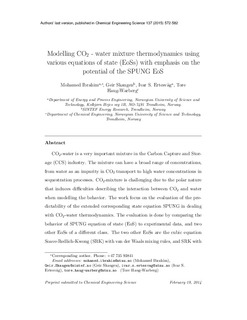Modelling CO2 - water mixture thermodynamics using various equations of state (EoSs) with emphasis on the potential of the SPUNG EoS
Journal article, Peer reviewed
Submitted version
Permanent lenke
http://hdl.handle.net/11250/2473379Utgivelsesdato
2014Metadata
Vis full innførselSamlinger
Sammendrag
CO2–water is a very important mixture in the Carbon Capture and Storage (CCS) industry. The mixture can have a broad range of concentrations, from water as an impurity in CO2 transport to high water concentrations in sequestration processes. CO2–water mixture is challenging due to the polar nature that induces difficulties describing the interaction between CO2 and water when modeling the behavior. The work focuses on the evaluation of the predictability of the extended corresponding state equation SPUNG in dealing with CO2–water thermodynamics. The evaluation is done by comparing the behavior of SPUNG equation of state (EoS) to experimental data, and two other EoSs of a different class. The two other EoSs are the cubic equation Soave–Redlich–Kwong (SRK) with van der Waals mixing rules, and SRK with Huron–Vidal mixing rules.
The predictability of the single and liquid rich phase densities, two-phase solubilities and dew line is investigated over a wide range of pressures, temperatures and mixture compositions. The results show better density prediction using SPUNG EoS over all the evaluated conditions compared to SRKs with a potential of improvements by changing the reference fluid. However, the CO2 solubility prediction using SPUNG requires the use of other mixing rules that can account for the polar nature of the system.
